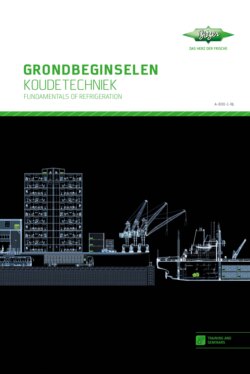Читать книгу GRONDBEGINSELEN KOUDETECHNIEK / In twee talen Nederlands/Engels - Volker Stamer - Страница 42
На сайте Литреса книга снята с продажи.
ОглавлениеFig. 8 Hogedrukreservoir met gemonteerde afsluiter
High pressure receiver with shut-off valve fitted [BITZER]
Het vloeistofvat bevat bij een correct koudemiddelpeil
twee afzonderlijke stoffen: koudemiddelvloeistof en
verzadigde damp. In systemen met een vloeistof
vat
bedraagt de onderkoeling aan de uittrede praktisch
0 K. Hierbij garandeert het vloeistofreservoir de ver-
eiste vloeistoftoestand.
Als alternatief of aanvulling kan het koudemiddel
worden gekoeld tot onder de condensatietemperatuur.
Het temperatuurverschil is de onderkoeling.
Zonder vloeistofreservoir ligt de optimale onderkoeling
gewoonlijk tussen 2 en 3 K bij de condensoruittrede.
Voor lage temperatuuur toepassingen verhoogt een
onderkoeling in de orde van 10 tot 15 K
of meer de prestaties en de efficiëntie. Dit vraagt
echter om speciale systeem-technische maatregelen.
3.3.2
Hoe ontstaat onderkoeling?
Voor een goede onderkoeling in de condensor wordt
een deel van de condensor d.m.v. opstuwing vóór het
expansieventiel gevuld met vloeibaar koudemiddel.
Het koelmedium dat door deze ruimte stroomt, koelt
het koudemiddel af.
Aangezien het condensatieoppervlak in de conden-
sor hierdoor kleiner wordt, neemt de condensatiedruk
toe, waardoor de efficiëntie van het systeem afneemt.
Daarom heeft het eigenlijk weinig zin om een onder-
koeling in de condensor te genereren.
If the refrigerant level is correct, the vessel contains
two separate phases: refrigerant liquid and saturated
vapour. In systems with a receiver, the subcooling at
the receiver outlet is practically 0 K. Here, the receiver
guarantees the necessary liquid barrier.
Alternatively, or additionally, the refrigerant can be
cooled to below its condensing temperature. The tem-
perature differential is the subcooling.
Without a receiver, the optimum subcooling is usually
in the 2 to 3 K range at the condenser outlet. In low
temperature applications, subcooling in the order of 10
to 15 K or more increases performance and efficiency,
in particular. However, special system engineering
measures are necessary to achieve this.
3.3.2
How is subcooling achieved?
To achieve subcooling in the condenser, part of the
condenser is charged with liquid refrigerant by back-
logging upstream of the expansion valve. The coolant
flowing through this area subcools the refrigerant.
Because the condensing surface area in the condenser
is thereby reduced, an increase in the condensing
pressure and thus lower system efficiency may result.
Consequently, it does not necessarily make sense to
achieve subcooling in the condenser.
44
Koeltechnische specificaties // Refrigeration parameters
